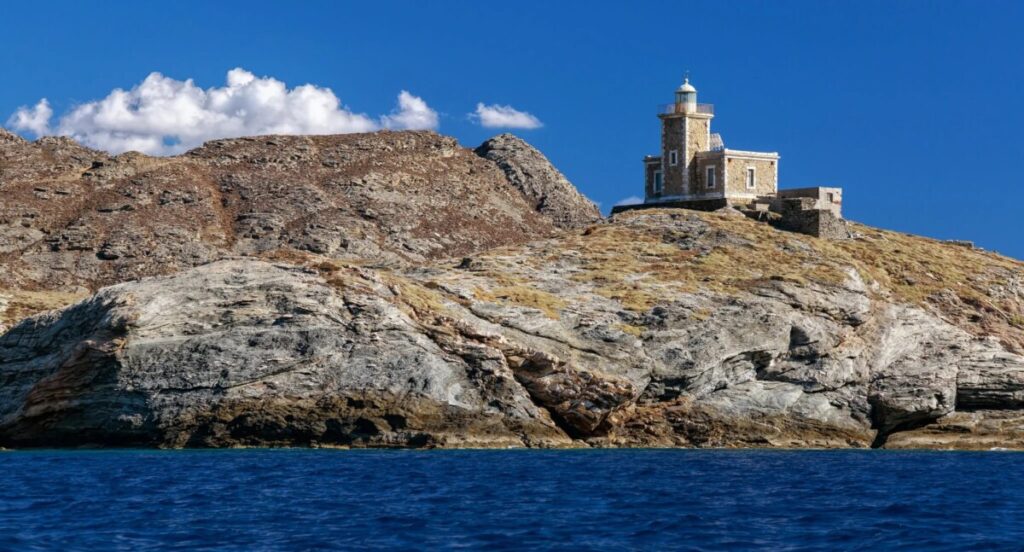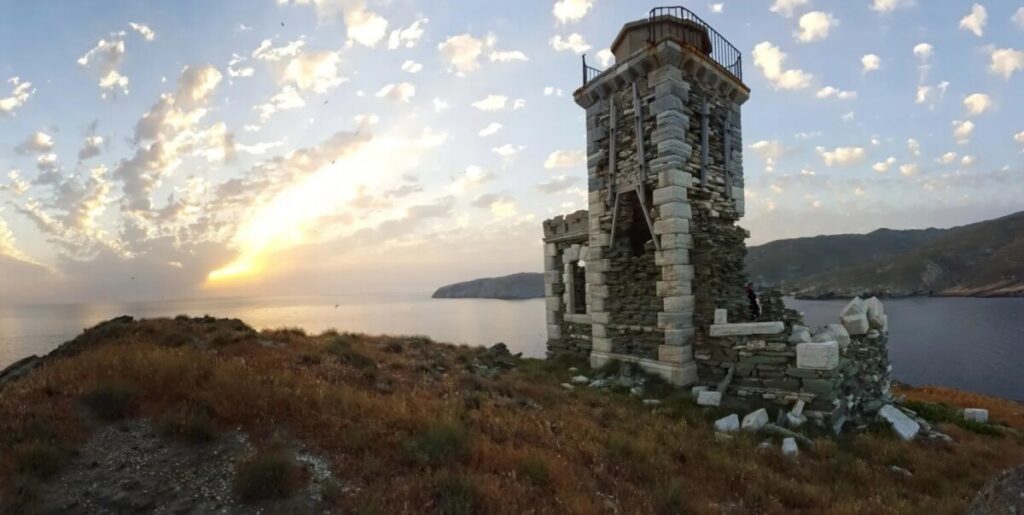When people think of Tinos, the first thing to come to mind is the Holy Church of the Virgin Mary Evangelistria, and not precisely lighthouses. But the lighthouses of the island are another reason why one should visit!
As Travel points out, the striking lighthouses of Tinos beckon one to gaze upon the open sea and experience the emotions felt by the lighthouse keepers of yesteryears.
The Lighthouse at Cape Papargyras

Perched on wind-swept Cape Papargyras to the east of Tinos is one of the most picturesque stone lighthouses in the Aegean. Constructed in 1910, it is deemed a crucial navigation lighthouse, delineating the passage from Chios to Ikaria and between the straits of Mykonos and Tinos.
The tower stands at a height of 10 metres, with its focal height reaching 41 metres.
A brief walk among the rocks of the cape provides a unique experience, with the commanding landscape evoking intense emotions. The area is often subjected to strong winds – it’s no coincidence that nearby stands Tsiknias, the tallest mountain of Tinos, which mythology associates with the North Wind.
Furious at Hercules for slaying his children, Zetes and Calais, he left his palaces in Thrace, found their graves here, and in his rage, unleashed his bags of wind, setting them free.
Close to the northern lighthouse lies Livada Beach, one of the island’s wildest and most beautiful spots, with its crystalline waters and fascinating rock formations reminiscent of Volax.
Head south of the lighthouse, and you’ll discover the charming sandy stretch of Santa Margarita or perhaps the allure of Lychnaftia.
Venture further southward, Pachia Ammos awaits with its dune, snuggled in a secluded bay with azure waters and rocks sculpted like art.
The Panormos Lighthouse on Planetis Isle

The stone structure and its four-sided tower, stretching up to eight metres, majestically stand just a short distance from the coastal settlement of Panormos, near Pyrgos. The tiny isle of Planitis is merely a stone’s throw from the coast, accessible by a short seaside walk along the settlement’s western edge.
This striking lighthouse, among the oldest in the Cyclades, was designated a preserved historical monument in 1998. First lit in 1886, it boasted a nine-mile range and showcases master craftsmanship with its stone and marble—a testament to the island’s rich resources.
It’s primarily a ‘harbour light’ rather than one for open-sea navigation. It ‘guards’ the harbour of Panormos, the only one north of Tinos, which renders it invaluable to local fishermen. It was automated in 1945.
For a dip, opt for the petite sandy shores of Agia Thalassa and Kavalaris (or Kavalourkou) near the lighthouse. From Panormos’ eastern side, head to Rohari Beach with its sandy stretches and turquoise waters—though a word of caution on windy days, when debris can mar its charm.
In Panormos, many fish tavernas, ouzeries, cafés, quaint shops, hotels, and rental accommodations beckon.
Although it might not appear so today, this little harbour once played a pivotal role in the island’s history. During Venetian rule, this haven, known then as Porto Palermo, stood as the sole natural port on the island’s northeastern side.
This gave it special military importance, marking it as one of the island’s four fortified harbours.
It also provided a safe refuge for merchant ships arriving from both east and west, which, especially when southerly winds prevailed, could not anchor in the bay of Agios Nikolaos – today’s city of Tinos.
For years after the Venetians, goods continued to arrive at Panormos from Greece and abroad, among which vast quantities of wheat were milled in the now-derelict windmills near the Tower.
The lighthouse on the small island of Dysvato, in the Andros-Tinos Strait

Venturing by boat to the small island of Dysvato, on the westernmost tip of the main island, and nearing its lighthouse that gazes out to the sea and the island of Andros beyond, one is bound to be overwhelmed by emotion.
Imagine how the lighthouse keepers must have felt, with their families bringing them supplies by navigating the rugged paths of the region before transporting them to the lighthouse by small boats. Between Dysvato and the mainland lies the islet of Kalogeroi.
Dysvato, which in Greek means hard to navigate, unsurprisingly is challenging to access from all directions. The sea remains calm only a handful of days per year, and the passage through the Andros-Tinos strait is bustling with activity.
Hence, the lighthouse rotates a full 360°, casting a powerful beam to illuminate the shores of both islands.
Built in 1903, its tower stood at 9 metres with a focal height of 33 metres. It was destroyed by the Germans in 1941, subsequently rebuilt, and resumed operation in 1945 with a lighthouse keeper until 1970. It then transitioned to an automatic process.
The waters surrounding the area are renowned as a prime fishing spot, and the islet is dotted with wild violets. Suppose you decide to journey to Dysvato by boat from Panormos. In that case, you can indulge in stops for refreshing swims at Koumelas and Mali, which serve as the local inhabitants’ summer retreats.
Like a quaint fjord, Mali boasts a pebbled beach, providing a serene escape.
READ MORE: 2,000 year old ‘Aerides’ Clocktower in Athens.


